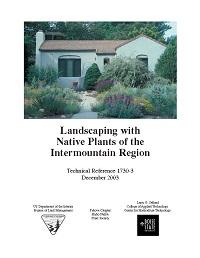Landscaping with Native Plants of the Intermountain Region

Whether for beauty, drought tolerance, wildlife, or hardiness, homeowners in the arid west are beginning to look to natives as alternatives for their landscaping needs. Each year, more visitors to the native plant gardens at the BLM in Boise, Idaho are asking questions about the plants featured: their names, how to grow, and where to find them. In response to the enthusiasm over native plants and to encourage their use, this guide is meant to aid in their selection, placement, and growth. This guide was conceived and compiled by southwest Idaho gardeners with experience growing native plants. For the purposes of this guide, we have defined a “native plant” as one that evolved in a particular area, and is therefore naturally adapted to its climate and soil. Many of the recommended plants are native to the Boise area, but all of the plants presented here are native to the Intermountain Region, the Southwest, or the Great Plains. The plants featured were selected for their relative ease of growth (assuming they are grown according to recommended cultural conditions), availability, and ornamental value. Because native plants should never be removed from the wild, a list of reputable sources is provided from which most can be obtained.
The format of this guide is subdivided into wildflowers, grasses, shrubs, and trees. Above the scientific and common name, symbols are used for quick reference to provide the following information: sun exposure, water requirements, pollinators it will attract (hummingbirds, butterflies, etc.), whether deciduous or evergreen, and its lowest USDA cold hardiness zone. Additional information is presented in roughly the following order in the text: height and width, color and time of bloom, unusual characteristics or cultural preferences (such as preferred soil conditions), value to wildlife when applicable, and any significant cultural, medicinal, or homeopathic uses, past or present. To quickly search for plants with specific criteria such as height, bloom time, or color, go to the Quick Reference Guide which follows the section on trees. Many are discouraged from using native plants because they’ve heard they are too finicky. Without modifying water use, or planting them according to their cultural requirements, many of these plants can indeed become finicky. To be successful, you’ll need to become well acquainted with your landscape: areas of high exposure, areas of shade, drainage, soil type, and microclimates. Once you’ve mapped it out in your mind, or ideally on paper, you can begin to match the specifics of the site with the cultural needs of the plants. When grown in the appropriate conditions, native plants should be very hardy, rarely needing fertilizers or insecticides.
The first year or two will require a little patience. The first spring and summer will not offer a dense show of foliage and color. Some plants require several years before blooming, and some are slow growing, which may be a drawback for those wanting immediate effect, but it can also be a real bonus when considering the reduced amount of pruning and trimming required. The first and possibly second year will require nearly the same water and weeding as a traditional garden. Because the soil has been turned up at planting time, and watering will be frequent to get the plants established, weeds may be particularly pesky. As the native plants become established, time spent watering will decrease which will dramatically decrease weed growth. Within a few years, the benefits will become apparent in their various forms: healthy beautiful plants, an increase in native birds and other pollinators, a lower water bill, and reduced use of chemicals in the environment.
